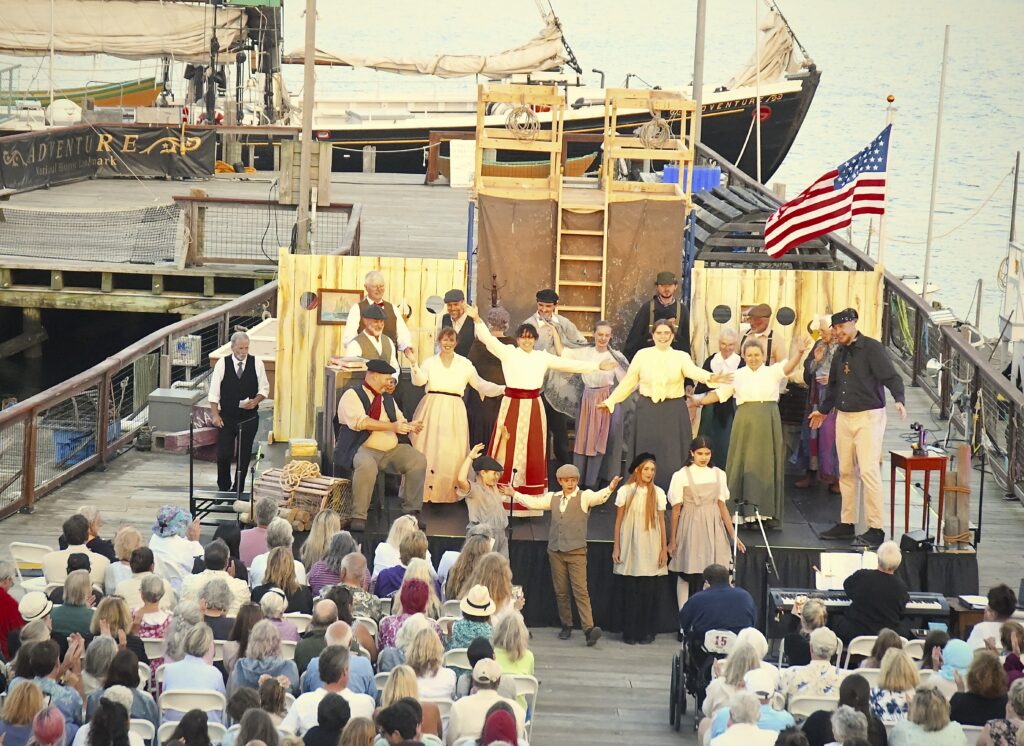In the summer of 1952, as the Cape Ann Festival of Literature and Drama was launching its inaugural event, Broadway playwright/librettist and Annisquam summer resident Russel Crouse agreed to sponsor a new challenge: A contest for “the best play about Gloucester by a resident of Gloucester.”
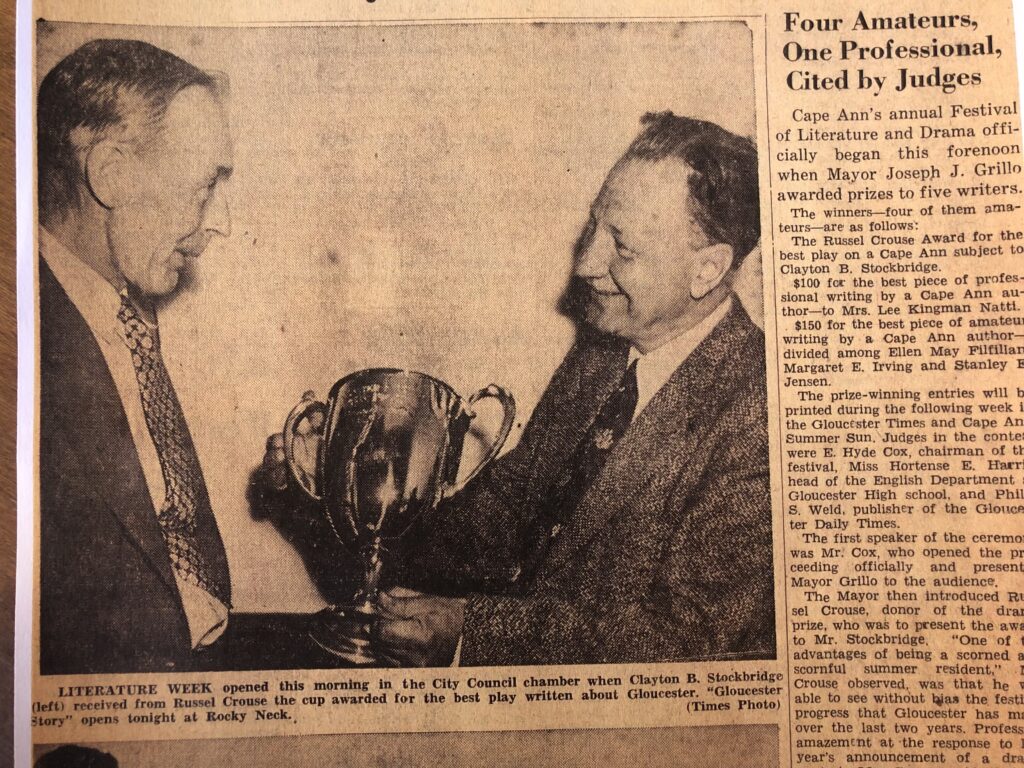
A year later, “Gloucester Story,” a two-act play written by Clayton B. Stockbridge (1895-1973), a plumber, emerged as the winner of the first Russel Crouse Award. (In 1954, the second and final Russel Crouse Award was given to Brown University professor and Annisquam summer resident S. Foster Damon for his play, “Witches of Dogtown.”)
The play was performed in Gloucester several times that summer and in subsequent years. For a short period of time, it became a popular pick for summer stock theatres. Various tweaks of the script occurred through the years.
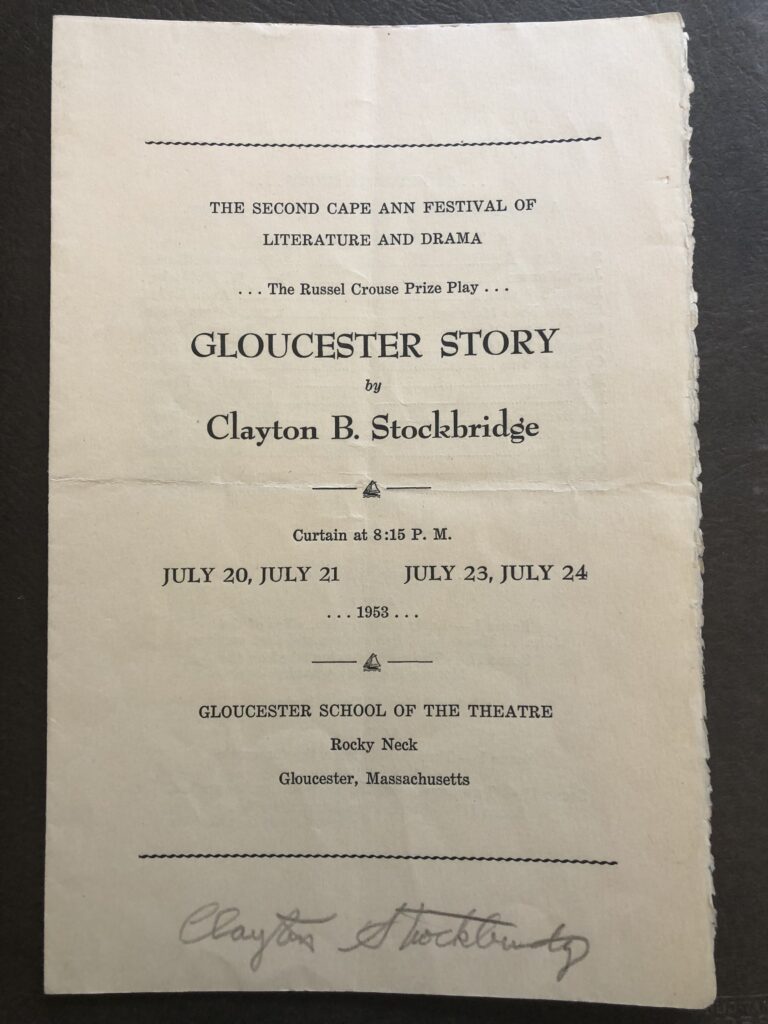
The story line, set in 1905, revolves around a 21-year-old son and his interactions with his family, his girlfriend, his fellow sailors, and the sea. It is entirely fictional but the names, businesses, and plot motivations dealing with the folklore are all factual.
It is a dramatic story of the fishing vessel Artemesia, which was lost at sea, and the conflict between the desire of a life at sea and the business of fishing. It involves a schooner vessel and a business owner’s son who wishes to crew on the vessel in order to have the life experience at sea and not be confined to a business life on shore. The son has resistance from his parents and fiancé in his quest to go to sea, and as a result becomes a part of the tragedy which strikes.
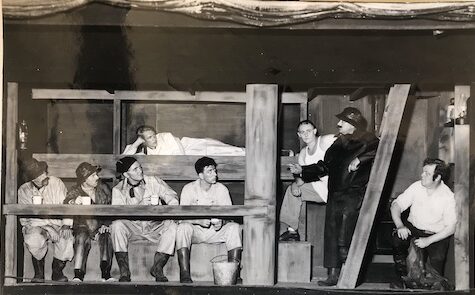
Clayton drew this story from his youth working on the docks of Gloucester Harbor during the age of the dory fisherman, incorporating popular Captains, local businesses, and the superstitions of the time. During that period, as other maritime cities of Massachusetts were devoting their resources to the Clipper ship trade or whaling, Gloucester chose fishing as its major contribution.
As the industry grew, there were three outstanding developments that Clayton took into account when creating “Gloucester Story.”
One of these was the Schooner
The need for speed, maneuverability and seaworthiness, made it mandatory to improve upon the slow, clumsy pinnaces and shallops used in the early years of fishing. From the time the first schooner slid down the ways of the shipyard at Eastern Point in 1713, its place was assured among fast sailing vessels. The highest accolade that could be conferred on a schooner was to be called “fast” and “able.”
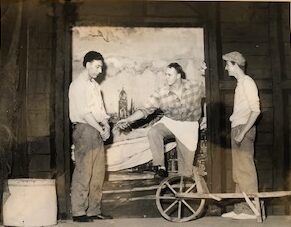
Another was the Dory
In 1793 Simeon Lowell of Amesbury had designed and built what he called a dory and, at the time, proved to be the most seaworthy small boat ever devised. Although only sixteen feet overall with a fourteen-foot flat bottom, it could hold close to two tons of fish – in addition to its two-man crew – without swamping. And they could be nested on a vessel’s deck so that several took no more space than one. It answered all of the requirements of the Gloucester trawlers and, after word got out, it was adopted by all of the world’s deep sea fishing fleets.
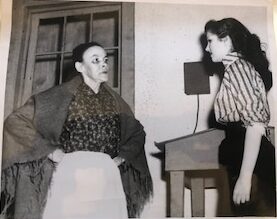
Up to the time of the invention of this type of rowboat, bank fishing had been done by hand from the vessel’s deck, but now the dory made it necessary for the crew to leave the vessel in small rowboats to set and haul in the fish.
Most of all the people
The last and most important of this trio is the people who made the others possible.
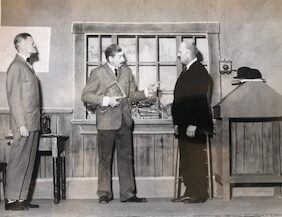
Youth from foreign countries back then, especially Canada, were attracted to Gloucester by the magnetism of the sea. The Gloucester fishermen became a breed apart. The navigational feats of the captains by dead reckoning were recognized throughout the Seven Seas. The fortitude, stamina and determination of the fishermen will never be excelled.
Some of their deeds are legendary. Without modern equipment such as sonar, radar and radio, the blinding fogs, sudden squalls and the unpredicted gales of the North Atlantic made bank fishing a most hazardous calling. During one five-year period, one hundred men were lost from just dories alone.
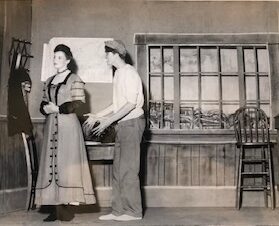
These men were extremely superstitious. Misfortune followed the breaking of taboos so often, that the superstitions were implicitly believed and taken for granted. The validity of the dream as an omen of disaster was one of their strongest convictions.
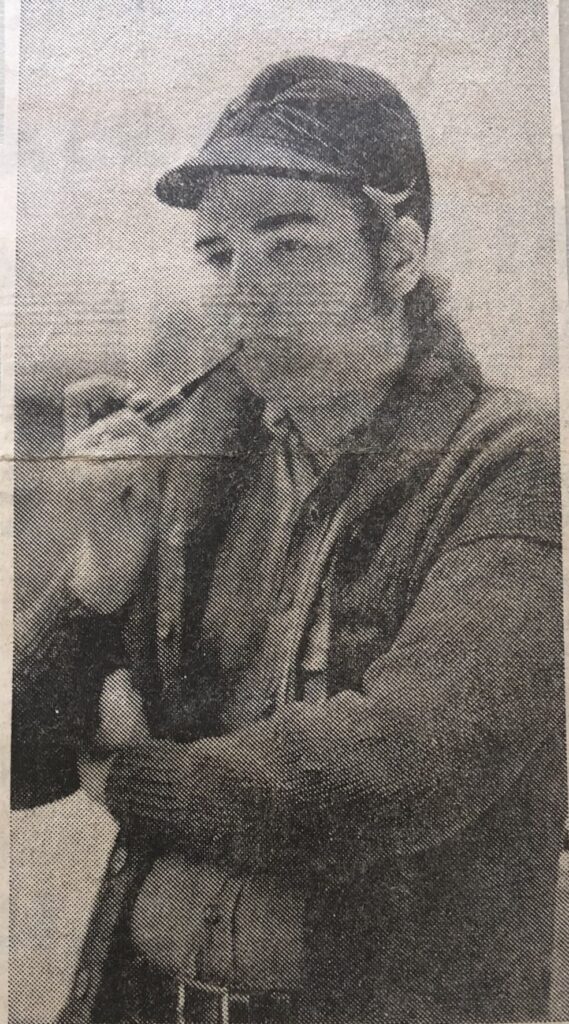
“Gloucester Story” takes you back, in fancy, to the turn of the century when the fishing industry was at the height of its development under sail. When Gloucester was the world’s leading fishing port — back when people, not machines, were the principal means of catching fish.
Through the scenes, Clayton strives to show a small picture of this era — forever gone— that typifies the heritage of the sea which is so uniquely Gloucester’s, and how some of these people lived and how some of them died.
In August 2023, the AVP transformed the Cape Ann classic into “Gloucester Story The Musical” in recognition of Gloucester’s 400th+ Birthday Celebration. With the help of local musicians – Dustin Ledgard, Daisy Nell, Peter Souza, and Corey Wrinn – various musical numbers with emotion and a salty beat were incorporated into the performance. And, to localize the event even more, the performances were held on the docks of old Gloucester Harbor alongside the schooners at Maritime Gloucester.
(Photo by Joe Wrinn)
(Photo by Paul Aquipel)
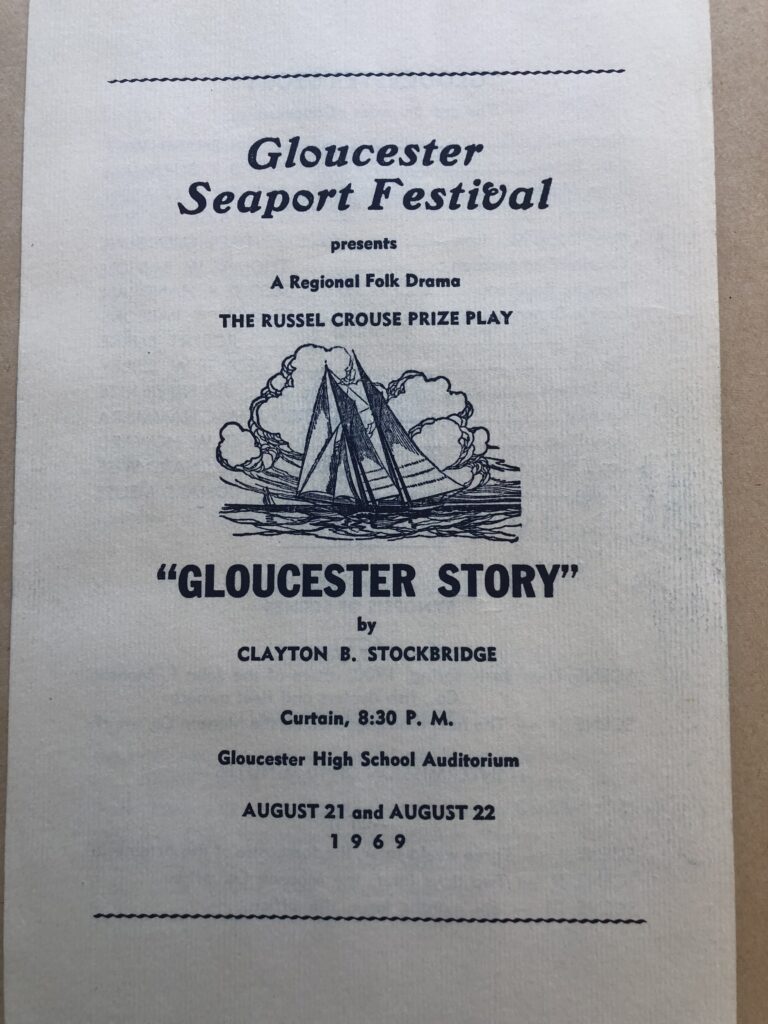
Past Gloucester Story Performances
- July 20-24, 1953 by the Gloucester School of the Theatre, Rocky Neck, as part of the Cape Ann Festival of Literature and Drama
- Summer 1954
- Aug. 2-3, 1963, for the Cape Ann Festival of the Arts, Gloucester High School Auditorium
- Aug. 21-22, 1969, as part of the Gloucester Seaport Festival, at the Gloucester High School Auditorium
- Summer 1996, for the Kipling Festival, at Brown’s Mall
- Aug. 10-13, 2023, set to music by the Annisquam Village Players as part of the Gloucester 400+ Birthday Celebration, on the docks of ol’ Gloucester Harbor
In July 1953 it was the talk of the town…

The following are a few of the articles transcribed from the Gloucester Daily Times reporting on Gloucester Story’s opening run in July 1953.
Gloucester Daily Times, July 20, 1953
Romance, Realism Blend in Work by Stockbridge
A Gloucester milestone was passed last night, and if the opening of Clayton B. Stockbridge’s play “Gloucester Story” didn’t quite rank with the launching of the first schooner, it came mighty close.
It was an opening night to end all opening nights; the house was jampacked, the audience demanded the author at the final curtain, celebrities and ordinary people mingled in the intermissions.

Gloucester breezes blew through the rugged little theatre at Rocky Neck.
Foghorns and sirens added their sounds to the slapping of the waves only a few feet from the building.
A violent thunderstorm struck right after the climax of the play – a collision at sea.
If the company had owned a “Standing Room Only” placard, it would have been hung well before curtain time. Among those turned away was Mrs. William B. Hawkes, one of the show’s publicity directors, which represents some sort of record in press agentry. Mayor Grillo, busy presiding at the weekly meeting of the city council during Act I, arrived at intermission time.
“Civic officials and summer residents smoked together between the acts and nobody cared, for the moment, about business. They weren’t in 1953 any more – for two and a half hours it was 1905.“
Gloucester Daily Times July 20, 1953
He took over the front-row seat of Hyde Cox, chairman of the Literature Festival, for Act II, while Mr. Cox stood in the rear. Alphonsus F. Hayes, port agent of the Atlantic Fishermen’s Union, arrived early but short a ticket. Playwright Stockbridge came to the rescue and gave his to Mr. Hayes, who thoroughly approved of the goings-on.
Back in 1905
Just about everybody was there. Russel Crouse, playwright and donor of the prize for the best play on a Cape Ann subject, made a short speech before the curtain and praised Mayor Grillo for backing plays instead of playing politics. The phrase seemed just right. Civic officials and summer residents smoked together between the acts and nobody cared, for the moment, about business. They weren’t in 1953 any more – for two and a half hours it was 1905.
Richard Bell, chairman of the festivals, was there, along with Mrs. Grillo, and finally her husband. The John Kierans came down from Folly Cove and someone spotted Alta Maloney, dramatic critic from the Boston Traveler. Actress Jean Dixon, wife of Edward S. Ely of Annisquam, and the first to read “Gloucester Story,” was there praising the amateur cast to the skies.
Director Joe Batcheller kept turning up in the crowd, to everyone’s surprise. “A good start has been made,” he said, with characteristic understatement. He meant the Festivals as a whole, and everyone agreed.
Quite An Occasion
The playwright himself – for over 30 years a plumber, and still active in the pipe-and-blowtorch trade – bobbed up nervously here and there, obviously savoring each second of a night which had long been a daydream. “Quite an occasion,” he observed.
When the play was over the applause lasted a solid five minutes, and cries of “AUTHOR!” became more and more strident.
Mr. Stockbridge, protesting, was dragged onto the stage; then he smiles shyly and presented each of the cast’s two ladies with a buss on the forehead. The curtain opened again to reveal director and playwright shaking hands; two large green boxes were presented to them and the curtain fell for the last time.
The audience left, buzzing with excitement over the play. They liked its lingo, its color, its handsome settings by painter Ken Gore.
Old-timers enthused over the realism of it. “Took me right back to the banks,” said one. The play rang with old Gloucester names – Cap’n Natti, the Sadie Nunan, Paul Jacobs, Charlie Heberle. And after it was all over, that inimitable local touch was there – the smell of fish and salt air.
— — — — — —
— — — — — —
Gloucester Daily Times, July 24, 1953
AS WE SAW IT
Gloucester Story;
“Gloucester Story,” the Russel Crouse Prize Play, a comedy-drama in two acts, by Clayton B. Stockbridge, presented at the Rocky Neck Little Theatre, July 20, 21, 22, 23, and 24. Directed by Joseph D. Batcheller, with the assistance of Mrs. Signe Burnham and William Robinson; lights by Susan Cole; scenery designed by Ken Gore.
Seth Bates Howard A. Curtis
John Monson Lores W. McCloskey
Deborah Wharton Anne Lodge
Capt. Nate Morrison Robert Natti
Charlie Fred Monson Robert Thomas
Frenchie Boudreau Robert Rapp
Cookie Brown John Meagher
Myron Raymond P. Fraser
Ike Joe Pallazola
Liz Brewer Elizabeth P. Poole
Nucky Harland W. Dann
Dory Plug Josh Tolford
Capt. Billy Hall Stanley Jensen
Waldo Robert M. Hubbard
A two-hour journey back to Gloucester’s Golden Age was taken by 250 people last Monday, through the courtesy of playwright Clayton B. Stockbridge and a group of enthusiastic amateur actors. All of it came by way of the Festival of Drama’s first annual presentation, and exciting and salty episode appropriately christened “Gloucester Story.”
This is the first of Mr. Stockbridge’s several plays, all of them written as a hobby, to be produced; and it represents an auspicious theatrical beginning for a man who has spent most of his life as a plumber. It is a solidly constructed, colorful drama, full of the tang of Gloucester language, and its opening night was a success in every sense. The Rocky Neck Little Theatre, rugged and wooden and cooled by the harbor breezes, made an ideal location for “Gloucester Story,” and the capacity house gave the cast and author a full five minutes of sincere applause at the final curtain.
Mr. Stockbridge himself nicely characterized the theme of the play in a program note:
“The Gloucester Story is dedicated to the memory of those iron men who fished from wooden vessels under sail. Its intent is to show an overall picture of the fishing industry at the height of its development under sail. It involves the owners, the captains, the fishermen, and the part a woman played in their lives. It places emphasis on the dory fishermen who, more than the other types, made Gloucester famous as a fishing port. The story is fictional. The episodes which have any bearing on the folklore and the superstitions are factual.”
And that describes it. In brief, the plot follows the fortunes of a young Gloucester boy who has a vital ambition to be a sea captain. His girl is a secretary in the office of his ship-owner father, and is violently opposed to the life of a fisherman; all of the objections to the seaman’s life are summed up in her pathetic pleas that Charlie Fred Monson stay ashore.
…couple as the sea-struck boy and his sweetheart; Robert Natti and Howard Curtis were impressive as the doomed captain and a white-collar man who always dreamed of the sea. In small character roles, Stanley Jensen, John Meagher, Elizabeth Poole, Harland Dann, and Robert Rapp all proved exceptionally able.
The sets, handsomely done by painters Ken Gore and Tom O’Hara were stunning, and Susan Cole’s lighting showed them off nicely.
“Gloucester Story” closes tonight. Anyone lucky enough to get a seat will undoubtedly leave in the same mood as the opening night audience, which departed with a virtually unanimous pride in sharing a part of Gloucester’s tradition.
– T.B.
— — — — — —
Gloucester Daily Times July 20, 1953
Almost a Sell Out
Noon report from the “Gloucester Story” box office are that the festival play was approaching a sell out on each of the three remaining nights. Tonight’s performance is sold out. The final show on Friday is near capacity. There were a few seats still obtainable for Thursday night. Remaining tickets can be procured at Shurtleff’s Waiting Station, the Rockport Mariner’s Bookstall, the Hatfield Color Shop in Rocky Neck or by calling -376.
— — — — — —
Guest Writer Proposes Toast To Gloucester
by MARGARET FORD KIERNAN
(Mrs. Keirnan, former Boston Herald columnist, now reviews books for the Atlantic Monthly and is working on a book of her own. She is the wife of John Kiernan.)
Last night’s performance of “Gloucester Story” by plumber Clayton B. Stockbridge of this city was a thing that even seasoned playgoers tagged as one of their best moving theatrical experiences.
Due to a combination of forces, of which the enthusiasm of the cast and the cooperation of the elements were only two, the production must surely go down as one of the most realistic in the history of the theatre.
Realistic?
Nonsense, it was real!
In a smashing first act finale, for example, with the crew of a fishing schooner bracing themselves for a ramming in the fog, the actual rain, wind, thunder and lightning going on outside the theatre put the audience into such a state of apprehension that many viewers honestly believe to this moment that they heard the ushers shouting, “Women and children first!”
Apart from the freshness that always accompanies an amateur performance (Kellys “The Torch Bearers” notwithstanding) there was a tonic in the clean-cut theme of the play itself – the struggle of one man between his love for a woman and his love for the sea.
People who look for social and political implications in everything they see behind the footlights would have been stymied last night. The only “leftist” tendency that turned up came when a liner was described as off the schooner’s “port” side.
It is traditional in the aftermath of an opening performance to say, “Now if they only do such-and-such to the second act, they really HAVE something.” But it is not within the province of this notice to offer such a suggestion. That is, rather, a toast to the town that fosters the talented playwright, actors, scenic designers and director, that made this civic and artisti enterprise an exciting thing.
There will be three more performances this week at the Gloucester School of the Theatre, Rocky Neck, and since it is a small place the prospective ticket buyer will do well to hurry, hurry, hurry. His time will be well spent, for this Russel Crouse prize play of ’53 is a gem.
1953 Original Cast and Crew
Seth Bates
Howard Curtis
John Monson
Lores W. McCloskey
Deborah Wharton
Ann Lodge
Captain Nate Morrison
Robert Natti
Charlie Fred Monson
Robert Thomas
Frenchie Boudreau
Robert Rapp
Cookie Brown
John Meagher
Myron
Raymond P. Fraser
Ike
Joe Pallazola
Liz Brewer
Elizabeth P. Poole
Nucky
Harland W. Dann
Dory Plug
Josh Tolford
Waldo
Robert M. Hubbard
Capt. Billy Hall
Stanley Jensen
1953 Production Staff
Director
Joseph D. Batcheller
Asst. Directors
Signe A. Burnham and William Robinson
Lighting
Susan Cole
Costumes
Signe Burnham
Makeup
Ann Muse and Sam Chiancola
Publicity
Jean Hawkes and Peter Anastas
Publicity Assistants
Bill Cafasso, Hyde Cox, John Bethel, Ken Gore, Delores Rapp
House Managers
Mrs. Charles M. Charleton, Mrs. Stanley Jensen
Ushers
Ellen Egan, Carol Moore, Mary Haskins, Mary Lou Rust, Connie Parent, Kay Sommers
1963 Cast and Crew
Narrator
Stanley C. Jensen
Seth Bates
Walter H. Kidder, Jr.
John Monson
Byron Russ
Deborah Warton
Sheila Ferrini
Capt. Nate Morrison
Robert Natti
Charlie Fred Monson
Paul Goodwin
Frenchie Boudreau
Arthur Lawson
Cookie Brown
Stanley T. Parsons
Myron
Dave Murray
Ike
Frank W. Anderson, Jr.
Liz Brewer
Margaret D. Ferrini
Nucky
Walter H. Kidder, Jr.
Dory Plug
Roger Howard
Waldo
Jeff Tyne
Capt. Billy Hall
Nelson Elliott
1963 Production Staff
Director
Mrs. Signe A. Burnham
Asst. Director
Stanley C. Jensen
Stage Manager
John Skaradrinski
Prompter
Barbara Russ
Makeup
Hale Anthony Johnson, Sam Chiancola, Howard Curtis
Properties
Robin Rhodes, Sandy McEwen
Technical Advisor
Terry H. Wells
Scene Design and Construction
Ken Gore
Screen Painting
Tom O’Hara
Construction and Painting Assts.
Jane Robbins, Denny Blodgett, Elizabeth Sibley, Reino Martin, Arthur Lawson, Juliet Bartlett, Raymond Fraser, June P. Southworth, Helen Lojek, Robert Perry, Suzanne O’Hara
House Manager/Tickets/Publicity
Mrs. C.W. Sibley, assisted by Marilyn Myett, Marion Babral, Doris Bayliss, William Costa, E.S. Bowling, Thomas Harvey, Joseph Devic, the Sea Scouts
Scripts
Ethel Mills, Kathryn Davis, Valier Lowe, Mena Familiari, James Spittle, Janet Grant, Marie Tortorici, Carol Baratt, Pauline Pucci
1969 Cast and Crew
Narrator
Richard Wise
Seth Bates
Howard F. Burnham
John Monson
Arthur J. Lawson
Deborah Wharton
Paige Dulong
Capt. Nate Morrison
Paul Lundberg
Charlie Fred Monson
Thomas W. Babson
Frenchie Boudreau
George B. Handran
Cookie Brown
Stanley T. Parsons
Myron
Robert Burke
Ike
George W. Sibley
Knucky
Fred J. MacNammara
Dory Plug
Roger W. Howard
Waldo
Donald Meuse
Capt. Billy Hall
Richard Wise
1969 Production Staff
Director
Nancy Webber
Production Manager
Donald Meuse
Makeup
Hale Anthony Johnson
Properties
Ann Hurd
Scene Design and Construction
Donald Meuse
Lighting
Wayne Whippen
Sound
Robert Burke
Construction and Painting Assts.
Samuel Coffin, Garry Russo, Cynthia Muise, Delores Larkin, Fredrick Sanborn, Virginia Spinney, Richard Wise, Paige Dulong, Wayne Anderson, Linn Doyle, Paricia Olsen, Ronald Woodard, Thomas Lovanne
Costumes
Barbara Parillo
House Manager
Richard Wise
Chairmen of Drama Committee
Mr. and Mrs. William F. McKay, Jr.
The 2023 Production of “Gloucester Story” is made possible by the generous contributions from our Sponsors:
Presenting Sponsor
Stage Level Sponsors
Space


